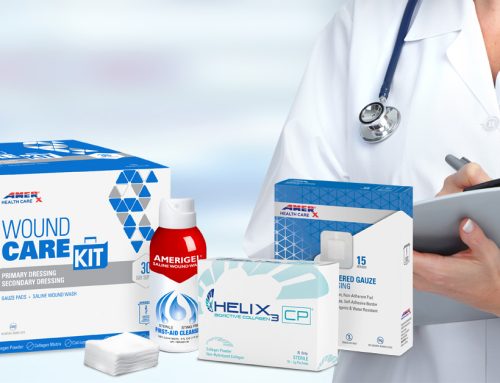One DMEMAC (CGS) recently released its quarterly report containing the top reasons for denials of surgical dressing claims1. Here, the top 5 reasons in that list are shared along with guidance regarding how to avoid each error in your practice.
1. Medical records do not support that the surgical dressings are required for either the treatment of a wound caused by, or treated by, a surgical procedure; or when required after debridement of a wound.
Providers must always document the medical necessity of surgical dressings when they are dispensed. In August 2021, I presented a webinar about Establishing Medical Necessity for AMERX Health Care, which is available to view on demand. This webinar explains the documentation of medical necessity that is referenced in this top reason for a claim denial.
2. The monthly evaluation of the wound by the healthcare professional did not include the type of each wound, its location, its size and depth, the amount of drainage, and any other relevant information.
In a previous blog post titled Adequate Wound Documentation, I detailed the requirements of the wound evaluation so you never commit this error. Practices with an active account with AMERX may also request free Documentation for Ulcer Debridement guidelines, specific to their DME MAC.
3. The medical records do not establish that the dressing is being used as a primary or secondary dressing or for some non-covered use (e.g. wound cleansing).
Whenever dispensing surgical dressings, the documentation must indicate whether the dressing(s) being dispensed are being used as a primary or secondary dressing. This requirement is thoroughly explained in my 2021 webinar, Documenting Primary Versus Secondary Dressings, which is available to view on-demand.
4. The medical records do not support frequency of use or frequency of change.
When dispensing surgical dressings, providers must document the anticipated length of time the dressing will be required. The frequency of dressing change must also be documented.
5. The size of the wound in the medical records does not support the HCPCS code billed.
The dressing size selected should be appropriate based on the size of the wound being treated. I have explored this concept in greater depth in my previous blog post, Choosing the Proper Dressing Size.

Dr. Jeffrey D. Lehrman, DPM, FASPS, MAPWCA, CPC, CPMA
Dr. Lehrman is a podiatrist practicing in Fort Collins, CO and operates Lehrman Consulting, LLC which provides consultation services regarding coding, compliance and documentation. Dr. Lehrman is a Certified Professional Coder and Certified Professional Medical Auditor. He serves as a staff liaison at the AMA CPT® Editorial Panel meetings where CPT codes are created, edited, and deleted. He is a Diplomate of the American Board of Foot and Ankle Surgery, Fellow of the American Society of Podiatric Surgeons, and is recognized as a “Master” by the American Professional Wound Care Association. Dr Lehrman is a Fellow of the American Academy of Podiatric Practice Management, Past Director of the American Professional Wound Care Association Board of Directors, and is a Past Chairman of the Board of the American Society of Podiatric Surgeons. Dr. Lehrman is also on the editorial advisory board of the journal WOUNDS.





